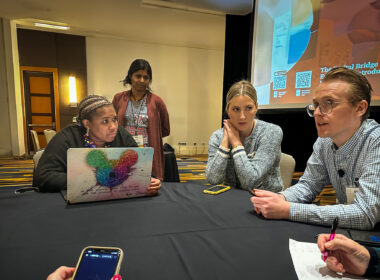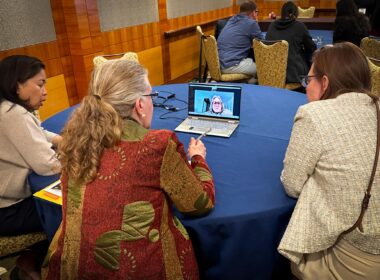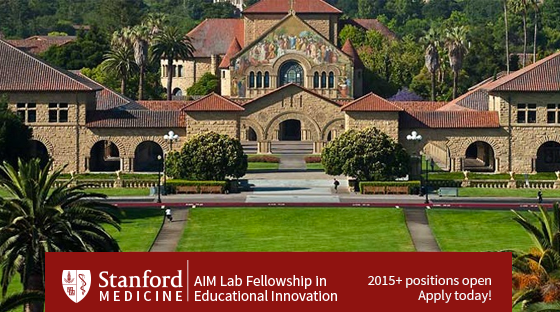
We are proud to offer a Stanford post-doctoral fellowship designed to provide anesthesiologists with the skills and experience to innovate the future of medical education. We are now accepting applications for 2017 and beyond.
Please call us with any questions: (650) 723-6632
Apply here
A year of learning at Stanford University
The AIM Lab Educational Fellowship is a year-long post-doctoral program for medical doctors in all specialties that aims to provide a rigorous didactic program and immersive experiential learning experience in medical education. Our fellows are distinguished by their thoughtful use of technology as a driver of educational innovation.
What does the fellowship look like?
Our 2014 AIM Lab Educational fellow is Janak Chandrasoma. Janak is a graduate of the USC department of anesthesia and joined the AIM Lab in August of this year.
Below you will find just a few of the exciting activities he has been pursuing as an Educational Innovation fellow in the Stanford AIM Lab this year:
Leading discussions on medical education at Stanford Medicine X.
In September, Janak moderated and directed conversations about innovations in healthcare and education at Stanford Medicine X, an internationally renowned conference on emerging technology and medicine. Medicine X is a catalyst for new ideas about the future of medicine and health care. The initiative explores how emerging technologies will advance the practice of medicine, improve health, and empower patients to be active participants in their own care. The “X” is meant to encourage thinking beyond numbers and trends—it represents the infinite possibilities for current and future information technologies to improve health. Where other technology conferences may focus on consumer trends or business-to-business needs, Medicine X will bring a broad, academic approach to understanding emerging technologies with the potential to improve health and advance the practice of medicine. Drawing on the best traditions of Stanford—an incubator of Silicon Valley—the conference aims to ignite interdisciplinary thinking and collaboration while encouraging a rigorous, quantitatively driven approach to understanding emerging technologies. In other words, the conference hopes to encourage “moon shot” thinking while actually offering the intellectual tools to make those ideas reality.
Putting learning design into practice at Stanford’s Graduate School of Education
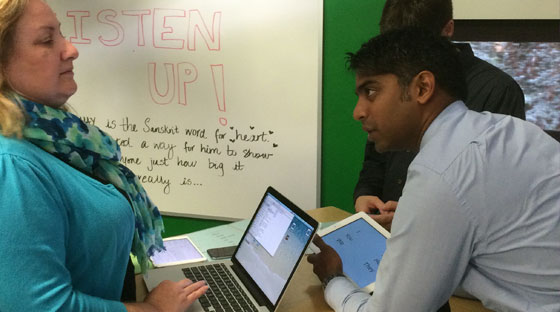 Technology for Learners is a popular and well-respected course in the Stanford Graduate School of Education. Janak has taken this class and other graduate offerings at Stanford, where he engages in interdisciplinary collaboration with students in the fields of business, education, and learning design. Technology for Learners explores the question: How can we use technology to improve learning? Many hope that technology will make learning easier, faster, or accessible to more learners. This course explores a variety of different approaches to designing tools for learning, the theories behind them, and the research that tests their effectiveness. Topics include feedback, visualization, games, multimedia, tangible-digital interfaces, simulations, and more. Students
Technology for Learners is a popular and well-respected course in the Stanford Graduate School of Education. Janak has taken this class and other graduate offerings at Stanford, where he engages in interdisciplinary collaboration with students in the fields of business, education, and learning design. Technology for Learners explores the question: How can we use technology to improve learning? Many hope that technology will make learning easier, faster, or accessible to more learners. This course explores a variety of different approaches to designing tools for learning, the theories behind them, and the research that tests their effectiveness. Topics include feedback, visualization, games, multimedia, tangible-digital interfaces, simulations, and more. Students
will work on teams to identify a need, create a prototype, and design tests to understand its impact. In close collaboration with actual schools in the area, learners can put their educational designs to the test in the real world, with real stakes. Take the opportunity to learn how to create, innovate, and advance educational technology.
Co-authoring a New England Journal of Medicine Video in Clinical Medicine
The AIM Lab has created video featured in the New England Journal of Medicine. Our lab has been invited by the journal to produce additional videos in this series. As an Educational Innovation fellow, Janak is involved in pre-production, production, and post-production of multimedia content for our next NEJM video. The NEJM Videos in Clinical Medicine series allows viewers to watch common clinical procedures on their computers or handheld devices. Peer-reviewed for accuracy and chaptered for easy reference, these videos provide a concise review of the procedure, including preparation, equipment, and more. New procedures are added frequently. Each video serves as an excellent teaching tool and point of reference. In addition, the AIM lab publishes a variety of media that can be viewed online by a global audience. Take part in learning how to create that content!
Launching a new anesthesia basic science podcast heard in over 20 countries
 Janak created and launched a new global podcast, STARTprep Radio Rehash, that has been viewed by anesthesiologists in over 20 countires. As the manager of daily operations at STARTprep, he has the opportunity to employ innovative educational techniques and technologies, including podcasts, MOOCs—and more! Each STARTprep module is packaged into an audio podcast, so that each piece of content can be reviewed daily both in audio and visual representations, in order to cement understanding. In order to meet the unique needs of millennial learners, the AIM lab creates multiple avenues to learn the same content, by engaging the learner in multiple forms of repetition learning.
Janak created and launched a new global podcast, STARTprep Radio Rehash, that has been viewed by anesthesiologists in over 20 countires. As the manager of daily operations at STARTprep, he has the opportunity to employ innovative educational techniques and technologies, including podcasts, MOOCs—and more! Each STARTprep module is packaged into an audio podcast, so that each piece of content can be reviewed daily both in audio and visual representations, in order to cement understanding. In order to meet the unique needs of millennial learners, the AIM lab creates multiple avenues to learn the same content, by engaging the learner in multiple forms of repetition learning.
Learning advanced techniques in educational media production
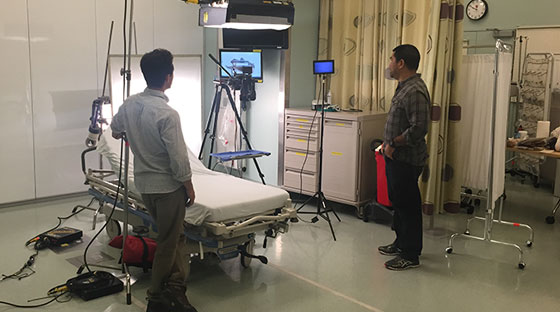 Educating learners in the modern age requires skillful, technological delivery of content. Become intimate and facile with the production of all types of educational content. Today’s millennial learners have never had trouble accessing a wealth of information at their fingertips. With this information comes a different problem: information sifting, and information overload. this new era of data exchange demands potent, effective systems of delivering this information in a way that is engaging, comprehensive, and digestible. It’s not good enough for educators to be good teachers. They must be aware of this information landscape, and develop learning tools directed to and molded around these specific learners. This can not only create successful learning, but a widespread educational footprint. At the AIM lab, fellows learn not only how to teach millennials, but to reach out and touch the minds of thousands of learners with each production.
Educating learners in the modern age requires skillful, technological delivery of content. Become intimate and facile with the production of all types of educational content. Today’s millennial learners have never had trouble accessing a wealth of information at their fingertips. With this information comes a different problem: information sifting, and information overload. this new era of data exchange demands potent, effective systems of delivering this information in a way that is engaging, comprehensive, and digestible. It’s not good enough for educators to be good teachers. They must be aware of this information landscape, and develop learning tools directed to and molded around these specific learners. This can not only create successful learning, but a widespread educational footprint. At the AIM lab, fellows learn not only how to teach millennials, but to reach out and touch the minds of thousands of learners with each production.
Putting anesthesiology knowledge into practice through Stanford OR anesthesia clinical care
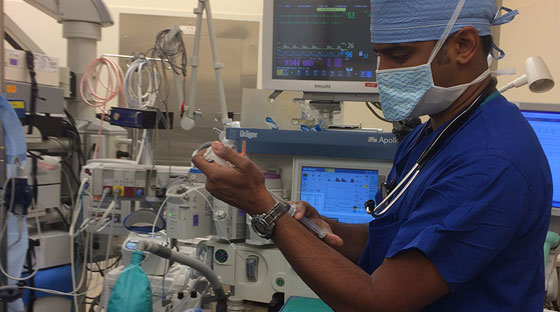 Your fellowship will include working in the Stanford operating rooms one day per week throughout the year. Engage in patient care as an attending, both in a supervisory role and as an independent practitioner. Hone your skills in one of the world’s most advanced surgical environments. At Stanford Hospital and Clinics, you can
Your fellowship will include working in the Stanford operating rooms one day per week throughout the year. Engage in patient care as an attending, both in a supervisory role and as an independent practitioner. Hone your skills in one of the world’s most advanced surgical environments. At Stanford Hospital and Clinics, you can
participate in world-class health care that not only seeks to lead medicine, but to pave new paths. Stanford has always been a leader in healthcare innovation, technology, and patient centered care. As an anesthesiologist in the operating room, you can participate in the highest standard of deliverable operating care, and set the bar high for your own clinical practice.
Lecturing on medical education at Stanford and the ASA Annual Meeting
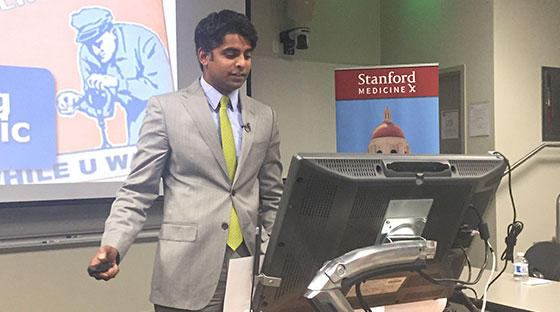 Become the face of STARTprep and the design and delivery of anesthesia education to over 1/4 of all of the anesthesia residents in the country. STARTprep is an extension of the AIM Lab’s successful START program. START – Successful Transition to Anesthesia Residency Training, is a year-long program during internship designed to help incoming residents feel more prepared to begin anesthesia residency training.
Become the face of STARTprep and the design and delivery of anesthesia education to over 1/4 of all of the anesthesia residents in the country. STARTprep is an extension of the AIM Lab’s successful START program. START – Successful Transition to Anesthesia Residency Training, is a year-long program during internship designed to help incoming residents feel more prepared to begin anesthesia residency training.
STARTprep takes up where START ends. It is a one-year curriculum designed to provide CA-1 residents with competency in the anesthesia basic sciences. Daily question and answer interactions, production of educational content, chapter editing, and quiz creation are just a few of the exciting, educationally robust tasks of the fellowship.
Learning techniques of medical moulage and simulation in medical education
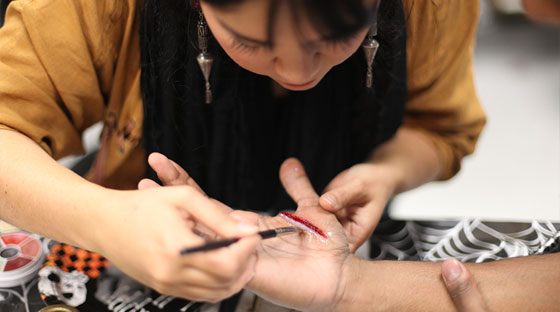 Learn to create educational experiences that go beyond pretending. You will work with Hollywood special effects artists to create realistic environments and disease conditions to create media and high fidelity simulations. You will work with Stanford simulation faculty, Kyle Harrison, MD, to learn how to plan, write and execute simulation scenarios.
Learn to create educational experiences that go beyond pretending. You will work with Hollywood special effects artists to create realistic environments and disease conditions to create media and high fidelity simulations. You will work with Stanford simulation faculty, Kyle Harrison, MD, to learn how to plan, write and execute simulation scenarios.
Simulation has long been crucial to the training of an anesthesiologist, and Stanford’s simulation program is second to none. The principles of simulation are not just to teach procedures and crisis management. The goal of simulation is to recreate experience, emotion, and feeling. Learn to engage and understand the process of simulation, create realistic environments and diseases, and provoke and modulate emotions of the learner. Create a scenario where students engage in an immersive experience that leads to learning that sticks.
Participating in cutting-edge educational research
Working closely with interdisciplinary teams, including engineers and educational psychologists at the Stanford Learning Lytics Lab and Harvard EdX, the AIM lab is on the forefront of education in the anesthesiology world. Learn not just how to create education technology, but how to validate it so that you can prove its relevance and efficacy for a new generation of learners. The AIM lab is not only producing research that is relevant to anesthesiology, it is producing research that is relevant to all of medical education, and education in general. With STARTprep, the lab has a wealth of data unlike any other in the country regarding users of an online medical class. Our research investigates the design of relevant content, while also exploring learning interventions that mold the class to the individual student—and ultimately prevent learners from falling off in their studies. These interventions, still a work in progress, would represent a huge leap forward for the fields of education and technology.
Apply here




